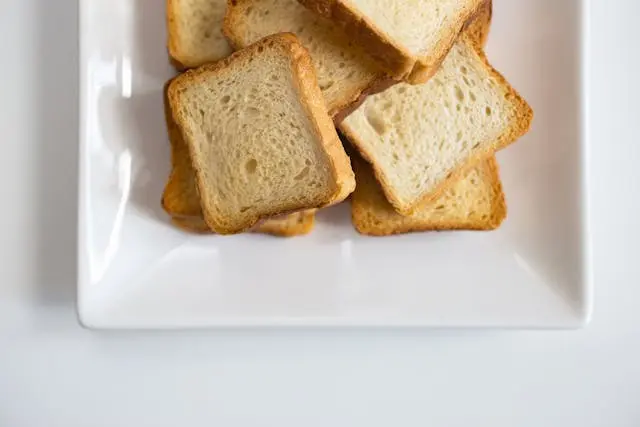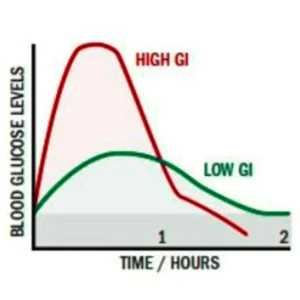
Some carbohydrate foods are more effective than others for weight loss.
The glycemic index is a valuable tool for identifying which carbohydrate foods to include in a fat-loss diet and which ones to limit.
The glycemic index measures how quickly certain foods can affect blood glucose levels. Foods that cause a rapid spike in blood glucose are categorised as high glycemic foods, and foods that cause gradual increases in blood glucose are called low glycemic foods.
Understanding the impact of high-glycemic foods is crucial to our journey toward better and more effective weight loss.
Table of Contents
Why Limit High Glycemic Indian Foods
While high glycemic foods aren’t inherently detrimental, they might not be the best companions on your weight loss adventure. Here’s why:
1. Low in Fiber: Foods that rank high on the glycemic scale are often fiber-deficient. Fibre gives bulk to your meals and slows the absorption, making you feel satisfied for an extended period. A low-fibre meal can make you feel hungry sooner, thus paving the way for sneaky snack cravings later.
2. Spike Blood Glucose: A high glycemic meal can skyrocket your blood glucose levels. In response, your body springs into action, releasing a surge of insulin, which aggressively brings it down. However, this can sometimes lead to a brief drop in blood glucose levels. Low blood glucose can create hunger pangs and cause you to look for some snacks to munch on.

3. Make you overeat: High glycemic foods, with their quick digestion, can sometimes outpace your brain’s signal of fullness, leading to the potential for overindulgence.
High Glycemic Indian Cereals
Cereals are a significant source of carbs in our diet, and choosing the appropriate cereals during weight loss is crucial. Opting for Indian cereals high on the glycemic scale could inadvertently become a stumbling block in your weight loss journey.
High glycemic Indian cereals are processed in the mills to strip away their fibre content. While this might make them quicker to prepare, it also propels their carbohydrates into the bloodstream rapidly.
Now, here’s the catch – the faster these carbs flood your bloodstream, the less it will be used for energy and more likely to be stored in fat cells.
On the flip side, let’s dive into the perks of opting for low-glycemic cereals. With their high fibre content, these cereals undergo a gradual digestion process, releasing carbs at a rate that your body can efficiently process. This means you get a steady supply of glucose, making it more likely to burn this glucose for energy instead of storing it in your fat cells.
Chart of High Glycemic Cereals
| Cereals | GI Value |
|---|---|
| Murmura (Puffed Rice) | 82 |
| White Rice | 73 |
| White Bread | 90 |
| Rajgira (Amaranth) | 70 |
| Makki Atta (Corn Flour) | 70 |
| Cornflakes | 85 |
| Ararot Powder (Arrowroot Powder) | 85 |
| Gehu Atta (Wheat Flour) | 85 |
| Chawal Atta (Rice Flour) | 95 |
| Instant Oats | 74 |
A quick word on legumes and dals
All legumes and dals have low glycemic scores, and you can opt for any variety of dals like moong dal, chana dal, toor dal, masoor dal or legumes like desi chana, whole moong, rajma. It is, however, a good idea to choose the unpolished dals over the polished ones. Why? Because they pack in more of the good stuff – extra vitamins, minerals, and fibre.
Indian Vegetables with High Glycemic Values
In the realm of Indian vegetables, you’ll find an abundance of low-calorie options boasting a low glycemic index. However, a handful of starchy veggies need a bit of moderation in your diet.
Vegetables like potatoes, sweet potato, and carrots, while nutritious, lean towards higher carbohydrate content with high glycemic scores. Enjoy them, but be mindful of those portions. Portion control is the secret sauce. Because, believe it or not, going overboard might throw a little speed bump into your weight loss journey. Suddenly finding yourself stuck at a weight plateau? Yep, those sneaky portions might be the culprits.
Chart of High Glycemic Vegetables
| Vegetables | GI Value |
|---|---|
| Boiled Potato | 70 |
| Cooked carrot | 85 |
| Boiled Shalgam (Turnip) | 85 |
| Boiled Kaddu (Pumpkin) | 75 |
| Shakarakanad (Sweet Potato) | 70 |
Indian Fruits with High Glycemic Values
In your quest for a healthier you, all fruits are welcome aboard! Yet, keep an eye on some with lower fibre and a higher glycemic index. Don’t worry; enjoying these fruits isn’t off-limits. Just keep it to around 150gm per day. Be mindful, though – these high glycemic fruits might not keep you feeling full for long, and you could end up overindulging.
Chart of High Glycemic Fruits
| Fruits | GI Value |
|---|---|
| Tarbuj (Watermelon) | 75 |
| Khajoor (Dates) | 70 |
| Angoor (Grapes) | 59 |
| Kela (Banana) | 60 |
| Aam (Mango) | 56 |
During your weight loss phase, opt for fruits that not only pack a nutritional punch but also keep you satisfied for an extended period. Make choices that are not just tasty but also low in calories. It’s all about savouring the journey while making fruitful, personalized decisions.
Why do fruit juices have a higher glycemic index?
Fruit contains a harmonious blend of fibre and natural sugars. The inherent fibre acts as a guardian, preventing the rapid absorption of sugars. However, the juicing process separates this protective fibre, enabling concentrated sugars to enter your body directly. The result? A surge in blood glucose levels.
Plus, the whole fruit provides more satiety than its juice. Always opt for whole fruits, which are rich in fibre.
List of common high glycemic Indian foods and their low glycemic alternatives
In addition to the previously discussed food groups, our daily diet often includes various packaged foods and food combinations. When striving for weight loss, prioritize low-glycemic foods over high-glycemic Indian foods. Familiarizing yourself with the glycemic values of these common foods available in Indian markets will help you make better decisions on your grocery shopping excursions.
| High GI Foods | Low GI Alternatives |
|---|---|
| White Rice | Brown Rice |
| Poha | Daliya |
| Instant Oats | Steel-cut Oats / Rolled Oats |
| Cornflakes | Muesli |
| Sugar | Stevia / Honey |
| White Bread | Whole Wheat Bread |
Conclusion
Remember, high glycemic foods aren’t the villains; they only need a bit of moderation during your weight loss journey. They play their part in a healthy weight-gaining diet, but for now, let’s be judicious in our choices. Here’s to making mindful decisions that support your health goals without compromising on flavour.
Leave a Reply